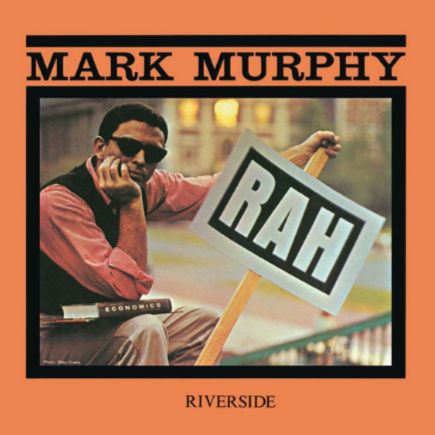Mark Murphy, l’âme vagabonde du jazz vocal
Chanteur de jazz américain au parcours singulier, Mark Murphy incarne une figure rare: celle d’un vocaliste à la fois héritier des grandes traditions et pionnier de la modernité. Né dans une famille de musiciens, il développe très tôt une oreille fine et un goût pour l’improvisation. Sa voix, claire et souple, évoque parfois celle de Mel Tormé, mais avec une expressivité plus brute, moins policée. Admirateur de chanteuses comme Lee Wiley et Peggy Lee, Mark Murphy se nourrit de cette élégance blanche et sophistiquée, tout en y insufflant une intensité émotionnelle d’un genre plus introspectif.
Diplômé de l’Université de Syracuse en 1953, où il étudie la musique et le théâtre, Mark Murphy est repéré par Sammy Davis Jr., qui l’invite à chanter à l’Embassy Club et le met en contact avec l’animateur Steve Allen. Installé à New York l’année suivante, il alterne petits boulots et auditions, cherchant sa voie entre chant et comédie. Après quelques albums aux ventes modestes, il s’établit à Los Angeles en 1958, où il enregistre trois disques et connaît un premier succès avec This Could Be the Start of Something.
Le tournant décisif intervient en 1961 avec l’album Rah!, enregistré à New York avec les arrangements d’Ernie Wilkins et la participation de Bill Evans et Wynton Kelly au piano. Ce disque révèle un artiste capable de passer du swing à la ballade et à l’improvisation libre, tout en gardant une cohérence expressive remarquable. L’année suivante, That’s How I Love the Blues, avec le saxophoniste Al Cohn, confirme sa maîtrise du langage jazz et sa capacité à incarner le blues avec intensité et retenue. En 1963, son interprétation de Fly Me to the Moon atteint les hit-parades américains et lui vaut d’être élu ‘nouvelle star de l’année’ par le magazine Down Beat.
Dans les années 1970, alors que la pop domine la scène mondiale, Mark Murphy s’installe à Londres et explore de nouveaux horizons, enregistrant et enseignant le chant jazz. Il retrouve la reconnaissance critique en 1981 avec Bop for Kerouac, hommage poétique à Jack Kerouac, où il entrelace textes parlés et improvisations vocales dans une atmosphère résolument expérimentale. Deux ans plus tard, il rend hommage à un autre géant avec Sings the Nat King Cole Songbook, où son timbre feutré et sa précision harmonique révèlent une tendresse toute nouvelle.
Mark Murphy, el alma errante del jazz vocal
Cantante de jazz estadounidense de trayectoria singular, Mark Murphy encarna una figura poco común: la de un vocalista heredero de las grandes tradiciones e impulsor de la modernidad. Nacido en una familia de músicos, desarrolló desde joven un oído refinado y un gusto natural por la improvisación. Su voz, clara y flexible, recuerda en ocasiones a la de Mel Tormé, aunque con una expresividad más cruda y menos pulida. Admirador de cantantes como Lee Wiley y Peggy Lee, Murphy absorbió de ellas una elegancia blanca y sofisticada, a la que añadió una intensidad emocional de carácter introspectivo.
Licenciado en la Universidad de Syracuse en 1953, donde estudió música y teatro, Mark Murphy fue descubierto por Sammy Davis Jr., quien lo invitó a cantar en el Embassy Club y lo puso en contacto con el presentador Steve Allen. Instalado en Nueva York al año siguiente, alternó pequeños trabajos con audiciones, buscando su camino entre el canto y la actuación. Tras unos discos de escasa repercusión, se trasladó a Los Ángeles en 1958, donde grabó tres álbumes y obtuvo su primer éxito con This Could Be the Start of Something.
El giro decisivo llegó en 1961 con el álbum Rah!, grabado en Nueva York con arreglos de Ernie Wilkins y la colaboración de Bill Evans y Wynton Kelly al piano. Este disco reveló a un artista capaz de pasar del swing a la balada y a la improvisación libre sin perder coherencia expresiva. Al año siguiente, That’s How I Love the Blues, junto al saxofonista Al Cohn, confirmó su dominio del lenguaje del jazz y su habilidad para encarnar el blues con intensidad y contención. En 1963, su interpretación de Fly Me to the Moon alcanzó las listas estadounidenses y le valió ser elegido “nueva estrella del año” por la revista Down Beat.
Durante la década de 1970, mientras el pop dominaba la escena internacional, Murphy se estableció en Londres, donde grabó, enseñó canto y exploró nuevos territorios musicales. Recuperó el reconocimiento crítico en 1981 con Bop for Kerouac, homenaje poético a Jack Kerouac en el que alterna texto hablado e improvisación vocal en una atmósfera experimental. Dos años después, rindió tributo a otro gigante con Sings the Nat King Cole Songbook, donde su timbre aterciopelado y su precisión armónica revelan una ternura inédita.
Mark Murphy, l’anima errante del jazz vocale
Cantante jazz americano dal percorso singolare, Mark Murphy rappresenta una figura rara: un vocalist erede delle grandi tradizioni e allo stesso tempo pioniere della modernità. Nato in una famiglia di musicisti, sviluppò fin da giovane un orecchio raffinato e un gusto naturale per l’improvvisazione. La sua voce, chiara e flessibile, ricorda a tratti quella di Mel Tormé, ma con un’espressività più diretta e meno levigata. Ammiratore di Lee Wiley e Peggy Lee, Murphy assorbì da loro l’eleganza sofisticata del jazz bianco, arricchendola con una sensibilità emotiva più introspettiva.
Laureato all’Università di Syracuse nel 1953, dove studiò musica e teatro, Mark Murphy fu notato da Sammy Davis Jr., che lo invitò a cantare all’Embassy Club e lo mise in contatto con il conduttore televisivo Steve Allen. Trasferitosi a New York l’anno seguente, alternò piccoli lavori e audizioni, cercando la sua strada tra canto e recitazione. Dopo alcuni dischi dalle vendite modeste, si stabilì a Los Angeles nel 1958, dove incise tre album e ottenne un primo successo con This Could Be the Start of Something.
La svolta decisiva arrivò nel 1961 con l’album Rah!, registrato a New York con gli arrangiamenti di Ernie Wilkins e la collaborazione di Bill Evans e Wynton Kelly al pianoforte. Questo disco rivelò un artista capace di passare dallo swing alla ballata e all’improvvisazione libera, mantenendo una sorprendente coerenza espressiva. L’anno successivo, That’s How I Love the Blues, inciso con il sassofonista Al Cohn, confermò la sua padronanza del linguaggio jazzistico e la sua capacità di esprimere il blues con intensità e misura. Nel 1963, la sua interpretazione di Fly Me to the Moon raggiunse le classifiche statunitensi e gli valse il titolo di “nuova stella dell’anno” secondo la rivista Down Beat.
Negli anni Settanta, mentre la musica pop dominava la scena mondiale, Murphy si trasferì a Londra, dove incise, insegnò canto e sperimentò nuove forme espressive. Riconquistò la critica nel 1981 con Bop for Kerouac, omaggio poetico a Jack Kerouac, in cui alterna recitazione e improvvisazione vocale in un contesto profondamente sperimentale. Due anni dopo, con Sings the Nat King Cole Songbook, rese omaggio a un altro gigante del jazz, mostrando un timbro vellutato e una dolcezza inedita.
Mark Murphy, the wandering soul of vocal jazz
American jazz singer Mark Murphy embodied a rare duality: a vocalist rooted in tradition yet boldly modern in expression. Born into a family of musicians, he developed a sharp ear and a natural taste for improvisation at an early age. His voice—clear, supple, and direct—sometimes recalled Mel Tormé’s tone, though with a rawer, less polished expressiveness. An admirer of singers like Lee Wiley and Peggy Lee, Murphy drew from their refined sophistication while infusing his own deeply introspective emotion.
After earning his degree in music and theater from Syracuse University in 1953, Murphy was discovered by Sammy Davis Jr., who invited him to sing at the Embassy Club and introduced him to TV host Steve Allen. The following year, he moved to New York, juggling odd jobs and auditions while pursuing careers in both singing and acting. Following a few modestly received albums, he relocated to Los Angeles in 1958, where he recorded three records and achieved his first success with This Could Be the Start of Something.
His breakthrough came in 1961 with the album Rah!, recorded in New York with arrangements by Ernie Wilkins and featuring pianists Bill Evans and Wynton Kelly. The album revealed an artist able to move fluidly between swing, ballad, and free improvisation, maintaining expressive coherence throughout. A year later, That’s How I Love the Blues, featuring tenor saxophonist Al Cohn, showcased his command of jazz language and his restrained yet powerful approach to the blues. In 1963, his rendition of Fly Me to the Moon reached the American charts and earned him the title of “New Star of the Year” in Down Beat magazine’s readers’ poll.
In the 1970s, as pop music dominated the global scene, Murphy moved to London, where he continued recording, teaching, and exploring new artistic directions. He regained critical acclaim in 1981 with Bop for Kerouac, a poetic tribute to Jack Kerouac that fused spoken word with vocal improvisation in a boldly experimental spirit. Two years later, with Sings the Nat King Cole Songbook, he revealed a more intimate side—his velvety tone and harmonic precision conveying an unexpected tenderness.


